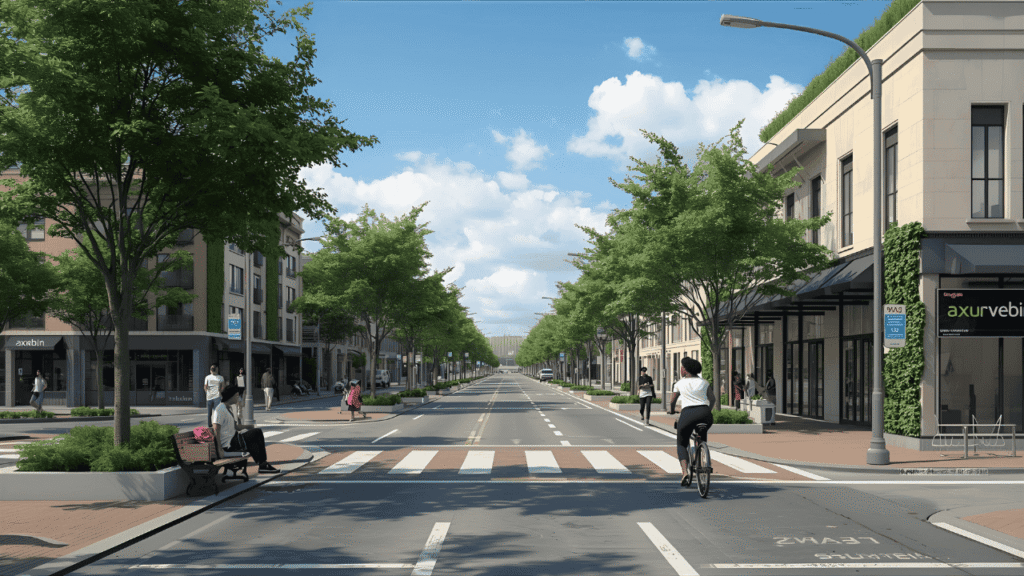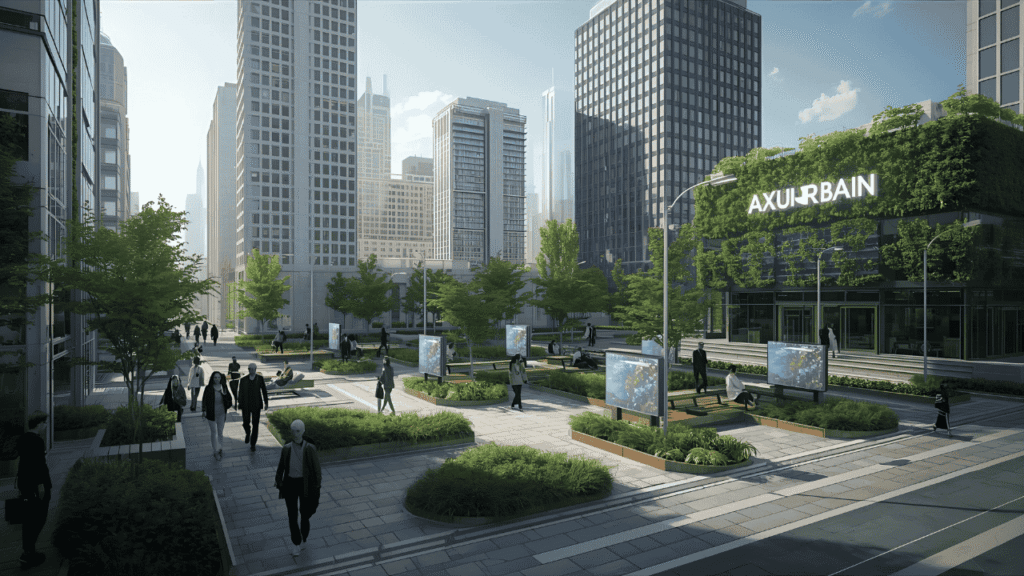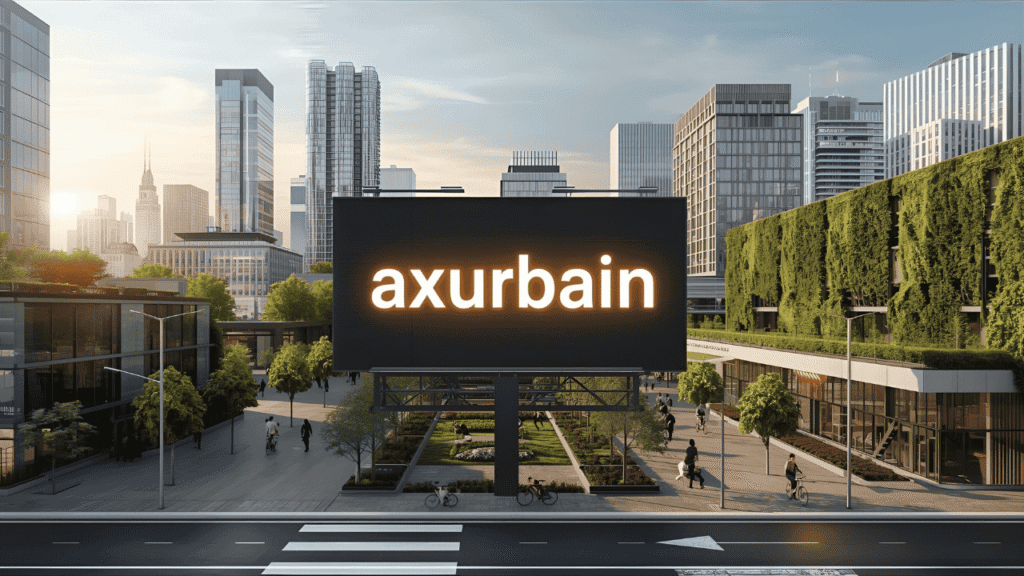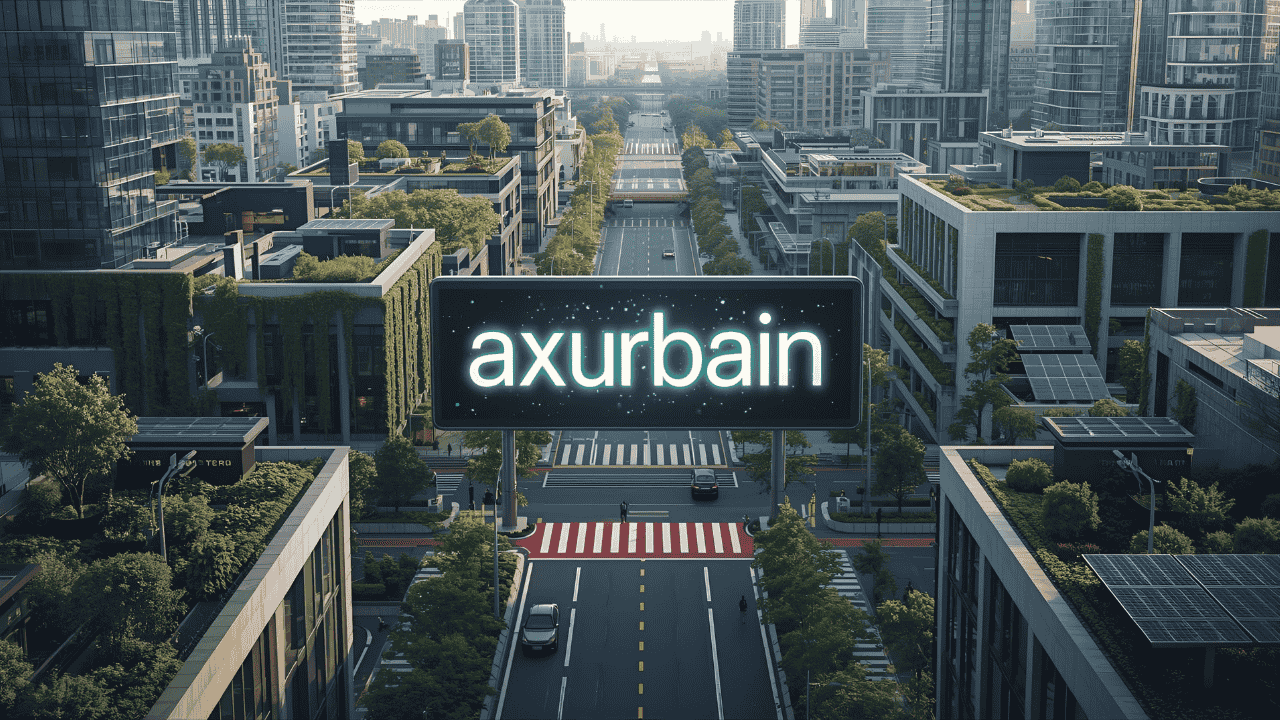Introduction — Why axurbain matters now
The word axurbain has started to appear in articles, blogs, and conversations about the future of cities. At first glance it reads like a branded idea or an aspirational label: a shorthand for a new approach that blends sustainable design, smart systems, public life, and citizen participation. Yet beneath the buzz there is an urgent question: is axurbain a coherent framework for action, a marketing term, or a mixture of both?
This long-form piece explores axurbain from several angles. It gathers what practitioners, commentators, and trend pieces say about the term, examines how real-world projects reflect the same principles, evaluates criticisms, and lays out practical steps that municipal leaders, designers, and community advocates can use to move from slogan to results. The aim is to give readers a clear, evidence-grounded view of axurbain so they can judge whether and how to adopt its ideas in their own places.
Throughout the article the focus will be on substance rather than hype: the policies, technologies, design choices, governance arrangements, and everyday practices that make city life healthier, fairer, and more resilient. The word axurbain will appear regularly, but always as a label for concrete ideas rather than an excuse for empty promises.
Origins and meanings of axurbain
A name that blends idea and place
The term axurbain is a compound that suggests a central axis around urban life: axis plus urbain (the French word for urban). That etymology hints at two complementary meanings. On one hand, axurbain is an organizing concept — a set of priorities and practices around which a city’s design and systems can be built. On the other hand, it functions as a brandable idea that can travel across blogs, case studies, and municipal reports.
Because the term is relatively new in public discourse, its precise definition varies by source. Some writers describe axurbain as a vision: integrated green spaces, modular housing, sensor-enabled services, and inclusive design. Others treat it as more rhetorical: a catch-all for popular smart city themes. Both uses matter, because they shape whether axurbain becomes a useful planning tool or dissolves into marketing language.
The dual existence: concept and company
Axurbain appears in two linked but distinct forms. One is the conceptual usage described above — the set of principles, technologies, and practices associated with modern urban transformation. The other is a real-world company or company name tied to urban furniture and public works. That firm focused on durable street furniture, customization for municipalities, and the small-scale industrial craft that shapes many public spaces. The existence of a company with the same name underscores a useful reminder: much of what changes cities happens at the scale of benches, bins, planters, shelters, and the small design choices that shape everyday life.
This duality — concept and craft — is not a contradiction. In fact, a robust approach to axurbain must combine the big-picture thinking of systems and strategy with attention to materials, maintenance, and lived experience.
Core principles behind axurbain

To move beyond the label and toward a workable program, it helps to identify the core principles that people associate with axurbain. These principles are drawn from multiple sources and real-world practice, and they form the backbone of a usable definition.
Sustainability by design
Cities that follow axurbain thinking emphasize durable, low-impact materials and systems designed to reduce carbon, conserve water, and support biodiversity. That includes passive design measures, green roofs, vertical planting, energy-efficient lighting, and a lifecycle view of materials that favors repair and reuse over single-use replacements.
Sustainability by design means thinking about maintenance and longevity as much as initial cost. A bench or planter that lasts many decades and is easy to repair delivers better environmental and economic value than one that must be replaced frequently.
Smart systems and sensor-driven services
Axurbain imagines urban infrastructure augmented by sensors and connected systems that provide real-time data on conditions like air quality, foot traffic, energy use, and waste levels. The goal is practical: to inform better operations, prioritize maintenance, and improve service delivery.
When deploying such systems, the emphasis is on usefulness rather than novelty. Sensor networks should reduce friction for users and managers alike, enabling faster repairs, smoother mobility, and more equitable allocation of resources.
Human-centered public spaces
Design for people is central to axurbain. That means public spaces that invite use — benches positioned to encourage conversation, shade that makes plazas comfortable in summer, clear signage for all residents, and accessible routes for people with mobility challenges. It also means acknowledging the intangible values of place: beauty, identity, safety, and everyday comfort.
Human-centered design considers who benefits from investments and how changes affect different demographic groups. Inclusivity and universal access are not optional extras; they are baseline requirements.
Circular economy principles
Axurbain thinking encourages systems that reuse resources and reduce waste. This can appear as design strategies (materials that are recyclable or repairable), shared infrastructure (bike fleets, tool libraries), and policies that incentivize refurbishment over disposal. Circular approaches also look at energy flows, encouraging local generation, storage, and microgrids where appropriate.
Participatory governance and local co-creation
Finally, axurbain puts people into the design loop. Projects are more durable and more legitimate when communities help set priorities, test prototypes, and steward outcomes. Participation can mean formal governance structures, neighborhood charters, or ad hoc co-design workshops. The practice helps avoid top-down mistakes and builds civic capacity.
How axurbain principles show up in real projects
The best way to judge a concept is to compare it to places that already practice similar ideas. Below are several widely cited projects and strategies that mirror the spirit of axurbain even when they do not use the label.
Vertical greening and integrated ecology — examples from major cities
Projects that incorporate vegetation into building facades and public infrastructure echo the sustainability pillar of axurbain. Vertical gardens and green facades reduce urban heat, improve air quality, and add biodiversity in dense areas. They show how built form and living systems can coexist.
Key takeaways for axurbain:
- Integrate planting as infrastructure, not decoration.
- Favor species that need low maintenance and are adapted to local climate.
- Plan for irrigation and access for maintenance from the start.
Reclaiming space for people — superblocks and pedestrian-first streets
Projects that repurpose streets and lanes for people — reducing car dominance and prioritizing pedestrians and cyclists — embody the human-centered core of axurbain. Examples include neighborhood schemes that slow traffic, widen sidewalks, and create play streets.
Key takeaways for axurbain:
- Small-scale interventions can produce quick wins for livability.
- Pilot projects and temporary installations help build public support.
- Equity matters: prioritize areas with fewer public amenities.
Adaptive reuse and public transformation — elevated parks and converted infrastructure
Turning disused infrastructure into high-quality public space is a powerful axurbain tactic. These projects show how creativity and civic will can unlock new kinds of public value without starting from scratch.
Key takeaways for axurbain:
- Look for underused assets as opportunities for public benefit.
- Design for phased activation, so spaces can evolve with community needs.
- Incorporate programming and maintenance plans to keep spaces lively.
Sensor-enabled operations and responsive maintenance
Cities that deploy sensor networks to monitor waste levels, lighting faults, or footfall patterns demonstrate how smarter operations support axurbain goals. The aim is pragmatic: allocate service resources more efficiently and reduce system downtime.
Key takeaways for axurbain:
- Start with priority use cases (waste, lighting, mobility) before scaling.
- Ensure systems are interoperable and manageable by municipal teams.
- Pair technology with clear governance about who owns and uses data.
The role of design and manufacturing in axurbain

Urban design is not just high-level strategy; it depends on products, production, and procurement. Companies that design and supply benches, planters, shelters, and play equipment are a critical part of how axurbain gets realized on the ground.
Craft, materials, and durability
Durability is a recurring theme in axurbain thinking. Whether a city is investing in modular homes, transit shelters, or street furniture, the choice of materials and manufacturing processes determines lifecycle costs and environmental footprint. Local craftsmanship, repair-friendly details, and modular components all help cities operate more sustainably.
Local production and community benefits
Where possible, sourcing materials and products from local manufacturers supports jobs and reduces transport impacts. Scaling local ecosystems of suppliers helps ensure that customizations are possible and maintenance parts are available — a practical requirement for long-term axurbain outcomes.
Procurement that values life-cycle thinking
Traditional procurement often prizes the lowest up-front cost. An axurbain approach encourages procurement models that weight long-term performance, service contracts, and the ability to repair or upgrade components.
Challenges and critiques: when axurbain risks becoming a buzzword
No emerging idea is immune from critique. The term axurbain has attracted skepticism, and some commentators argue the label sometimes masks vaporware: attractive language that lacks measurable projects, named leaders, or clear outcomes.
The danger of idea drift and empty branding
If a term becomes a grab bag for every desirable city attribute, it loses meaning. Axurbain risks becoming a rhetorical blanket that obscures real trade-offs: between density and green space, between rapid deployment and equitable participation, or between short-term spectacle and long-term maintenance.
Financial and regulatory constraints
Many of the ideas associated with axurbain require upfront investment and regulatory flexibility. Cities with tight budgets or rigid zoning rules may struggle to pilot innovations. Success often depends on blended finance models, public-private partnerships, and phased implementation strategies.
Privacy, data ownership, and surveillance concerns
Sensor networks and connected infrastructure raise legitimate questions about who controls data and how personal information is protected. Any city pursuing an axurbain approach must design data governance frameworks that safeguard privacy, ensure transparency, and give residents a say in how information is used.
Retrofitting and legacy infrastructure
Older cities with historic cores face a particular challenge: retrofitting smart or green systems into streets and buildings that were not designed for them. Such interventions require careful technical planning, community consultation, and patient implementation.
Digital inequality and access
Technological enhancements can improve services, but they also risk leaving behind those without access to devices or digital literacy. Axurbain must pair digital upgrades with community training, accessible interfaces, and alternative low-tech options.
Practical steps to implement axurbain principles
For city officials, designers, and community leaders ready to test axurbain ideas, a sensible implementation strategy blends pilots, partnerships, and measurement.
Start small and scale deliberately
Pilot projects create opportunities to test assumptions before major investments. Temporary parklets, pop-up markets, or sensor pilots for waste collection can demonstrate value and build political capital.
Build partnerships and blended finance
Public-private partnerships, philanthropy, and social investment instruments can help bridge funding gaps. Contracts should align incentives, protect public interest, and require transparency about costs and outcomes.
Prioritize community co-creation
Engage residents early and often. Co-design workshops, neighborhood advisory boards, and open procurement processes increase legitimacy and surface practical insights that designers may miss.
Measure what matters
Define indicators that reflect human outcomes: time saved, accessibility improvements, reduced emissions, increased use of public space. Metrics must be public, comparable, and reviewed regularly to guide course corrections.
Create open governance frameworks for data
Set clear rules for data collection, storage, use, and access. Wherever possible, prefer anonymized or aggregated data and provide mechanisms for residents to opt in or out.
Plan for maintenance from the outset
Long-term success depends on steady maintenance budgets and the availability of parts and skills. Design choices should minimize maintenance complexity and prioritize repairability.
Technologies and innovations that support axurbain
Axurbain-friendly cities use a mix of technologies that enhance service delivery without becoming ends in themselves. The emphasis is on applied solutions that reduce friction and improve quality of life.
Sensor networks and monitoring systems
Environmental sensors, occupancy detectors, and infrastructure monitors provide actionable information. Priority applications include street lighting optimization, waste collection efficiency, and air quality monitoring.
Digital twins and planning tools
Digital twins — high-fidelity digital models of physical neighborhoods — can help planners simulate scenarios and test interventions before making costly changes. They support better decision-making for resilience, traffic flow, and resource allocation.
Automation and predictive operations
Automation tools help municipal teams operate more effectively, from predictive maintenance schedules to automated alerts for faults. These systems are most valuable when paired with human oversight and robust governance.
Immersive tools for community engagement
Augmented and virtual visualization tools help residents understand proposed changes. Immersive simulations can bridge the gap between technical plans and lived experience, making participation more meaningful.
Design innovations: materials and modular systems
New materials and modular approaches reduce construction time and increase adaptability. Prefabricated modules for housing or street shelters enable phased deployment and easier upgrades.
Economic and social impacts to expect from axurbain-style projects
When axurbain principles are well-implemented, they can generate a range of positive outcomes. Yet impacts vary with context, and design choices shape distributional effects.
Economic benefits
Better public spaces and more reliable services can attract business, increase foot traffic, and boost property values. However, careful policy design is needed to avoid displacement and preserve affordability.
Social and health benefits
Access to green space, active mobility options, and safe public areas improves mental and physical health. Inclusive design reduces barriers for older residents and people with disabilities.
Environmental gains
Energy efficiency, local renewables, and reduced vehicle dependence lower emissions. Circular approaches to waste and materials reduce resource extraction and landfill pressure.
Risks of uneven benefits
Without explicit equity goals, gains may concentrate in wealthier neighborhoods. Equity-minded planning and targeted investments are needed to ensure broad benefits.
A simple checklist for city leaders and practitioners
To make axurbain ideas practical, here is a compact checklist that can guide early action:
- Identify a high-impact pilot area with measurable needs.
- Convene a stakeholder group including residents, designers, and maintenance staff.
- Define clear objectives and outcomes for the pilot.
- Choose technologies and designs that are interoperable and service-oriented.
- Secure maintenance commitments and lifecycle budgeting.
- Set up transparent data governance and privacy protections.
- Monitor outcomes and publish results publicly.
- Use lessons learned to scale or adapt projects across the city.
This checklist is intentionally concise. Each item can be expanded into a small project plan depending on local capacity and context.
Common objections and how to respond

Critics often raise similar objections. Here are pragmatic responses that keep the conversation focused on outcomes rather than rhetoric.
Objection: axurbain is just a trendy label.
Response: Labels matter less than outcomes. If a project improves health, reduces emissions, increases access, and lowers costs over time, it is useful regardless of what it is called. Use the term as a shorthand, but insist on measurable goals.
Objection: we can’t afford it.
Response: Prioritize low-cost, high-impact interventions first. Pilot programs and phased investment can demonstrate returns that unlock larger funding. Explore partnerships and grants for innovation.
Objection: technology creates surveillance risks.
Response: Design data governance before deployment. Use privacy-preserving data methods, anonymization, and clear opt-in policies. Transparency and community oversight reduce risks.
Objection: retrofitting older areas is impossible.
Response: Start with incremental interventions: lighting improvements, street reallocation, or pocket plantings. Over time these projects create constituencies for larger investments.
Looking ahead — scenarios for the future of axurbain
The future of axurbain will be shaped by two forces: the quality of implementation and the integrity of governance. Below are three plausible scenarios.
Scenario 1: axurbain becomes a practical municipal playbook
In this scenario, cities adopt the core principles systematically. Clear metrics, pilot programs, and procurement reform turn the concept into a proven set of practices. Local manufacturing and maintenance ecosystems adapt, and communities see measurable improvements in daily life.
Scenario 2: axurbain remains rhetorical and fragmented
Here the term proliferates in blogs and corporate materials but lacks coordinated action. Projects that use the label are inconsistent, and public skepticism grows. Without sustained evidence, the concept fades as a trend.
Scenario 3: axurbain evolves through community-led innovation
In the most democratic path, neighborhoods and civic groups adopt selective axurbain practices, tailoring them to local needs. Grassroots projects scale horizontally and pressure municipal systems to change procurement and governance to support broader adoption.
The most desirable outcome combines elements of the first and third scenarios: systematic municipal leadership informed by community experience.
Practical examples of small-scale axurbain interventions
To make the concept tangible, here are small, implementable interventions that reflect axurbain thinking and can be scaled.
- Convert one commercial parking lane into a pedestrian plaza for a year to test economic and social impacts.
- Install sensor-enabled waste bins in three neighborhoods to reduce collection costs and litter.
- Launch a program for green roofs on municipal buildings, started with a single school.
- Pilot a modular shelter with integrated solar lighting and charging in a transit hub.
- Organize a co-design series with seniors to make a local park more accessible.
Each intervention is small enough to be affordable yet valuable as a learning lab.
Closing reflections and concluding thoughts
Axurbain captures a compelling set of ambitions for the modern city: less waste, more beauty, better services, and more meaningful participation. The phrase itself will not change streets or housing, but when the principles it represents are translated into clear pilots, measurable goals, and accountable governance, real transformation follows.
This article has tried to balance aspiration with realism. It has shown how elements of axurbain already exist in practice, how the term risks becoming mere rhetoric, and how cities can pursue practical steps that deliver tangible benefits. For municipal leaders and civic advocates, the next step is straightforward: test, measure, learn, and refine. Wherever the label appears, demand evidence and build systems that sustain change over time.
axurbain is not a magic formula, but it is a useful rallying idea if applied with discipline. City-building has always been a mixture of vision and craft. The promise of axurbain is strongest when those two elements are held together: imaginative goals anchored in the materials, maintenance, and participation that make urban life possible.
Conclusion
Cities around the world are standing at a crossroads. Climate change, rapid urbanization, digital disruption, and social inequality are pressing challenges that no single solution can fix. Yet, within these challenges lies an opportunity to rethink how cities grow and function. This is where axurbain becomes more than just a word. It emerges as a guiding idea that brings together sustainability, innovation, human-centered design, and community-driven governance.
The journey of axurbain is not about building futuristic skylines alone; it is about making daily life better for residents — safer streets, cleaner air, inclusive public spaces, smarter transport, and opportunities for all. By adopting durable materials, leveraging smart technologies responsibly, and ensuring citizens are part of the design process, cities can move closer to the vision that axurbain represents.
At the same time, caution is essential. Without clear goals, accountability, and real projects, axurbain could fade into yet another buzzword. The real power of axurbain lies in measurable results: greener infrastructure, reduced energy costs, thriving public squares, resilient services, and healthier communities. Municipal leaders, planners, businesses, and residents all share the responsibility to make this concept actionable rather than rhetorical.
Frequently asked questions about axurbain
What follows are concise responses to common questions readers raise when thinking about the term and its practical implications.
What is axurbain in one sentence?
Axurbain is an organizing concept for urban design that combines sustainability, smart systems, human-centered public space, circular economy principles, and participatory governance.
Is axurbain a real movement or just marketing?
It depends. Elements of axurbain are already practiced widely. The risk is that the term becomes a marketing bucket; its real value comes from translating principles into measurable projects.
Can small cities adopt axurbain approaches?
Yes. Many axurbain-aligned practices are scalable and suitable for smaller municipalities, especially low-cost pilots and community-led initiatives.
How should a city measure success?
Measure human-centered outcomes: accessibility improvements, public use of spaces, energy savings, maintenance costs, resident satisfaction, and equitable distribution of benefits.
Who should lead axurbain projects?
Multi-stakeholder teams that include municipal departments, local manufacturers or suppliers, civic groups, and designers work best. Leadership can rotate depending on the project phase.
